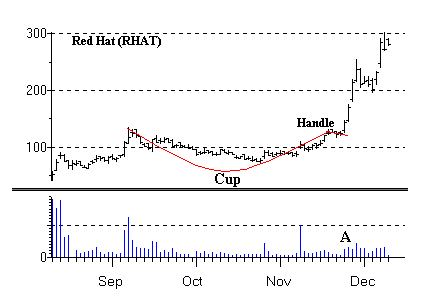Chart Patterns (Buy Signals)
When to buy a stock is always a difficult decision. However by analyzing chart patterns and associated price and volume movements investors should become more comfortable with these decisions. There are several different types of chart patterns however I tend to focus on the Cup with a Handle, Flat Base and Double Bottom patterns.
1. Cup with a Handle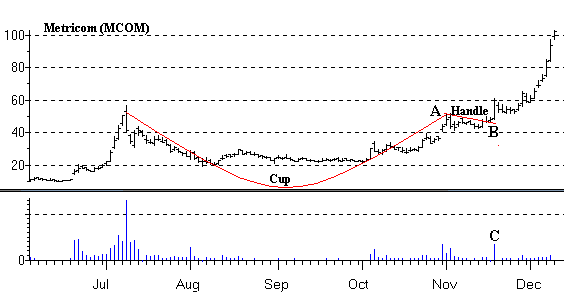
($50 to $100) in the next 4 weeks.
RHAT is another good example of a Cup and Handle pattern. RHAT formed a Cup from early September to mid November and then formed a very short term Handle (4 days). RHAT then exploded out of the Handle (point A) with increasing volume in late November. The stock then rocketed from $130 to $300 in three weeks for a gain of 131%.
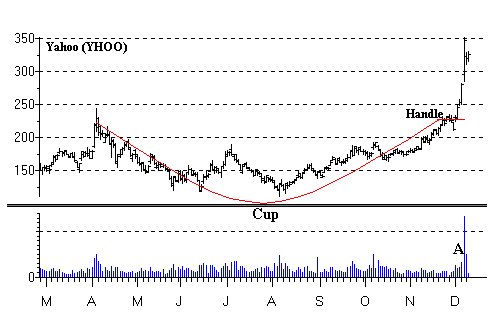
YHOO took about 8 months to form a bigger picture Cup (April to December) after making a top in early April. It then formed a very short term Handle for about 6 days and then broke out of the Handle in early December with increasing volume (point A). YHOO then soared from $225 to $350 in 4 trading days for a gain of 56%.
The next chart pattern we will look at is the Double Bottom. Click on the link below to see examples
2. Double Bottom
The Double Bottom pattern looks like the letter "W" and if recognized correctly can lead to a good entry point for investors. Some examples are shown below.
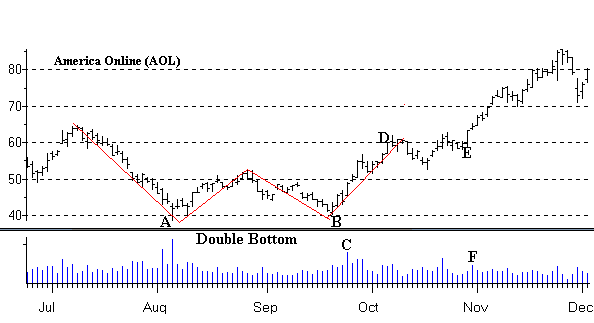
AOL formed a Double Bottom ("W" shape) this past Summer and Fall. Notice that after it made its first bottom (point A) in early August it then rallied briefly and then pulled back and made the second bottom (point B) in late September. AOL then rallied again to complete the "W" shape by early October. Investors that were able to recognize this Double Bottom pattern could have made a good entry point as AOL came out of the second bottom on increasing volume (point C). Meanwhile after forming the "W" shape AOL then traded sideways during the month of October (points D to E). Then AOL broke out of the trading range in late October with increasing volume (point F). Investors who recognized the Double Bottom pattern were rewarded with a 100% gain in eight weeks as AOL's price went from $40 to $80.
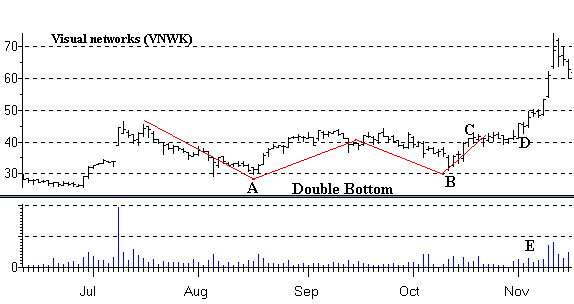
Another example of a stock making a Double Bottom was VNWK although this Double Bottom was much more elongated. Notice that VNWK made a top in mid-July and then pulled back to $30 by mid-August (point A). It then rallied back into the lower $40s in September and then pulled back again to around $30 by mid-October (point B). After forming the "W" shape VNWK traded sideways for two weeks (points C to D) and then broke out of its trading range in early November with increasing volume (point E). After breaking out VNWK went from the lower $40s to lower $70s in two weeks for a gain of 71%.
The next type of chart pattern we will look at is the Flat Base pattern. Click on the link below to see some examples of this pattern.
Flat Base Pattern
Stocks that have large price gains typically will stair-step upward and form Flat Bases before resuming their up trend. This action may occur several times as a stock remains in an up trend and could last from a few days to several weeks depending on the situation. Flat Bases are characterized by small daily trading ranges with volume being lower than normal. Although it doesn't happen every time, the longer a stock remains in a Flat Base, the greater the price appreciation may be when the stock breaks out. Lets look at some examples below.
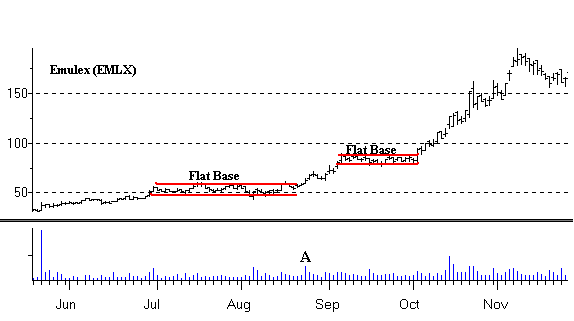
Here is a chart of EMLX. Notice how it formed a Flat Base (small trading range) from July through mid-August and then broke out of the base in on increasing volume (point A). It then formed another Flat Base in September and broke out of this base in early October and skyrocketed from $80 to $200.
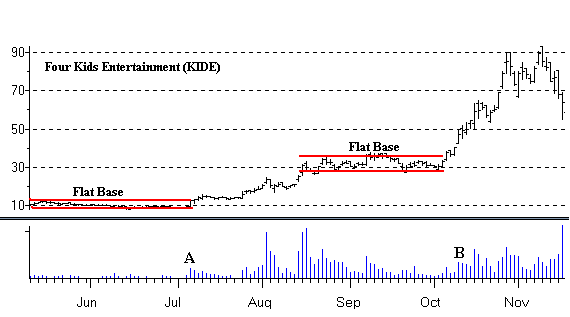
Another example of a stock that had a few Flat Bases was KIDE. Notice in May and June the small daily trading ranges with low volume. Then in early July the stock broke out with increasing volume (point A) and went from $10 to $30 by mid-August. KIDE then formed another Flat Base from mid-August though early October and then exploded out of the base on higher volume (point B). The stock then went from $30 to $90 in four weeks. The total gain from July to November was 800% ($10 to $90).
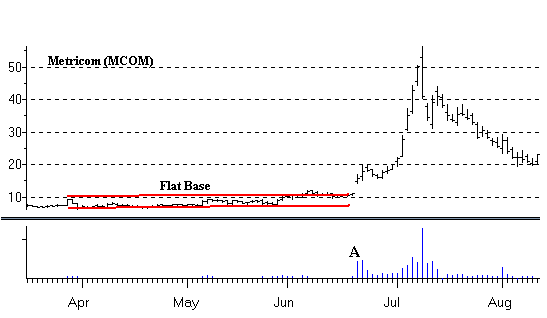
Another example of a stock that was in a Flat Base pattern for a significant amount of time was MCOM. Notice that it traded sideways for at least 3 months before breaking out of the base on strong volume (point A). In this case MCOM went from $10 to $55 in 4 weeks for a gain of 450%.
As you can see, finding stocks that exhibit certain chart patterns (Cup and Handle, Double Bottom and Flat Base) can lead to strong price appreciation when they breakout on strong volume.
Charts (Sell Patterns)
When to sell a stock is a more difficult decision than buying a stock in my opinion. If you sell too early then you may miss a significant move upward and if you hold a stock too long, then it may drop all the way back down to what you purchased it for or even below that. Stocks have a tendency to drop more quickly than they rise. For example it may take several weeks for a stock to go from $50 to $100 but it may only take a few weeks or even less for it to drop from $100 back to $50. So as an investor you should pay close attention to what the charts look like when you decide to buy or sell a stock. Some chart patterns that warn me of a potential reversal include a Climax Top off a Parabolic Move, Double Top and the Head and Shoulders Top.
1. Climax Top Off a Parabolic Move
This pattern occurs when a stock rises very quickly out of a base and gets overextended. Stocks in a Parabolic Move can double or triple in value in a very short period of time (usually less than two weeks). As an investor you certainly don't want to be one of the last passengers on the train and get quickly thrown off. Some examples of this pattern are shown below.
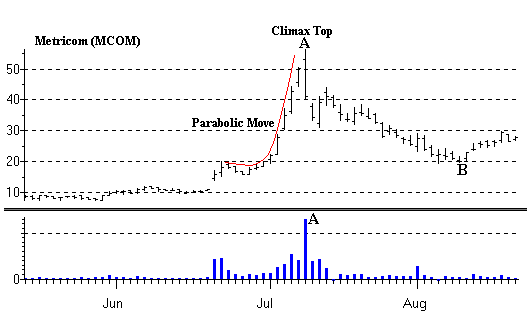
Notice the quick move upward in MCOM back in July. In 5 trading days it went from $20 to $57 for a gain of 185%. Also notice that on the biggest volume day (point A) that it gapped up strongly to $53 and then closed poorly around $41. This was the Climax Top Off the Parabolic Move. As an investor you should have sold this day if you had bought the stock in the $20's. Meanwhile you certainly should have not bought this stock this day. Notice how the stock eventually pulled all the way back to $20 by early August (point B).
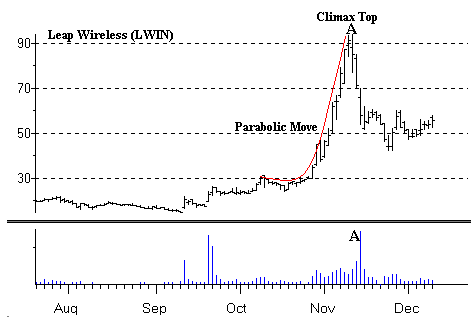
Another example of a Climax Top Off a Parabolic Move is demonstrated by LWIN. This stock skyrocketed from $30 to $95 in 10 trading days for a whopping gain of 217%. The Climax Top occurred on the 10th and 11th days of trading as the volume peaked (point A). The stock then sold off and retreated back quickly to around $42 by late November.
As you can see stocks that go up very quickly, in a Parabolic Move, can also come down just as fast. My advice is if you buy a stock and it doubles or triples in value in a very short period of time (1 to 2 weeks) take your profits and congratulate yourself for a job well done. If you become greedy then you could lose most of your gains as the above examples indicate. Furthermore if your buying a stock in this type of move be very careful and watch out for the Climax Top if the stock is trading on its biggest volume day.
The next type of chart topping pattern we will look at is the Double Top. Click on the link below for some examples.






